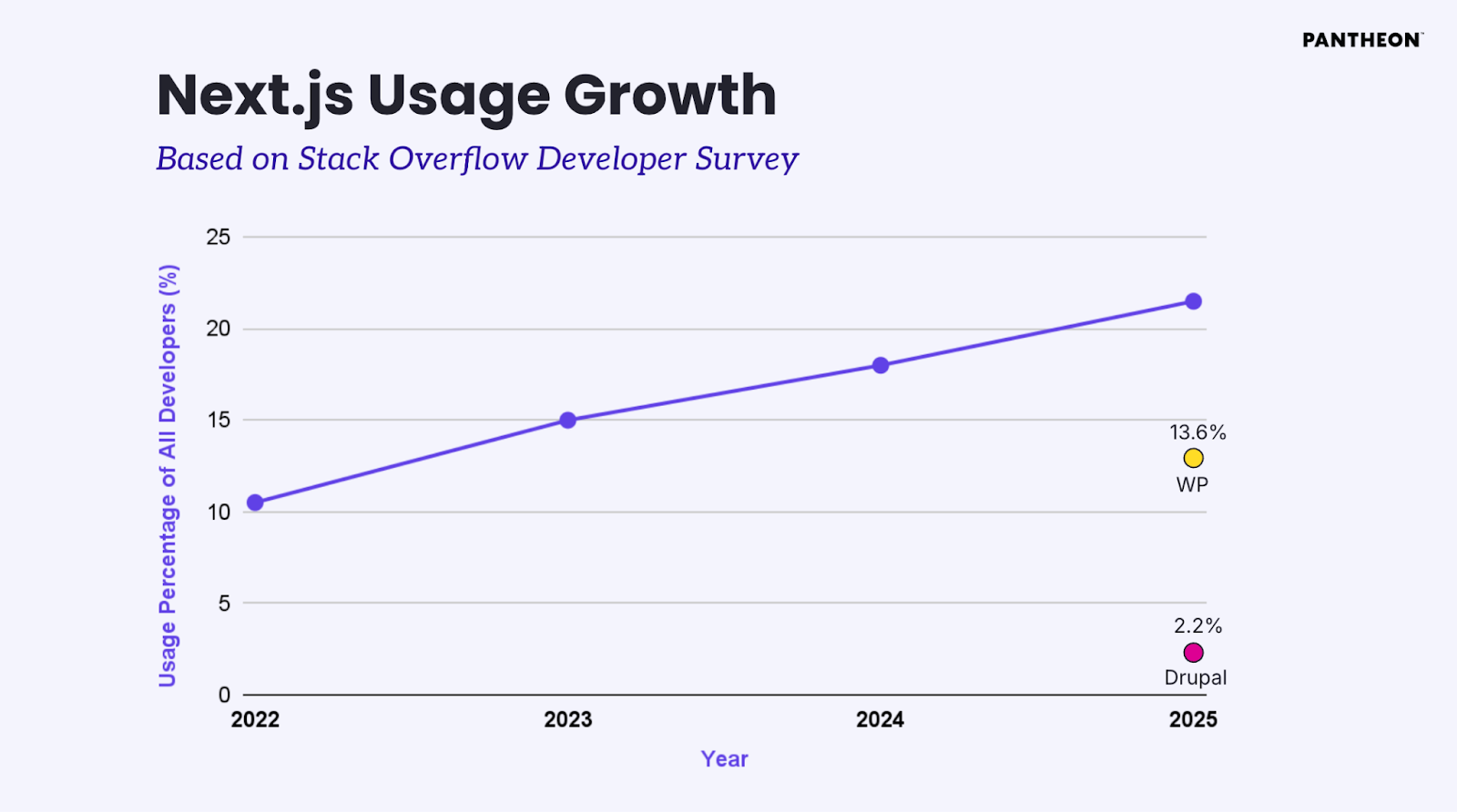The Web Is Dynamic: Next.js on Pantheon Enters Private Beta
Today marks a significant milestone as Next.js on Pantheon enters a private beta, bringing the experience of creating and managing a Next.js site into the same seamless, professional-grade platform you already know and love for WordPress and Drupal.
At Pantheon, we believe all first-class web systems—WordPress, Drupal, or Next.js—deserve the same top-tier ergonomics and infrastructure.
Request access to Next.js on Pantheon, in beta now!
Dynamic by Default and the Rise of Next.js
Last month, as I watched the annual NextConf, I was heartened to see a slide declaring "Dynamic by default" when describing some of the changes in the newly released Next.js 16.
That approach matches how we've architected our infrastructure to run Next.js sites.
In the decades that Pantheon's leadership has been working on the web, we've seen pendulum swings go from an assumption of:
- "Static by default" in the 90s…as flat HTML files were FTP'd straight up to production.
- "Dynamic by default" in the 2000s…as LAMP stack systems like WordPress and Drupal grew and were wrapped in caching to maintain performance.
- Back to "Static by default" with the rise of the JAMStack in the 2010s…which provided great answers to speed and security for end users but struggled to keep content fresh.
Now in 2025, the most ascendant web framework, Next.js, is trumpeting "Dynamic by default" with appropriate leveraging of caching as the way forward for thinking about most any given web page.
Sounds good to us. "Dynamic by default" has worked very well for thousands of sites on Pantheon for over a decade when we add in caching layers accessible by the server-side application and a CDN in front of the server-side application (and yes, Next.js is fundamentally a server-side application!).
We expect this mindset will make Next.js more adoptable by web teams in our ecosystem who do not want to mentally juggle different rendering strategies across various pages within a given site.
How We Run Next.js Now: The Architecture
Depending on who you ask, Next.js might either be incredibly complex to host or simple enough for a small VPS. We're aiming for an answer somewhere in the middle.
Global CDN
First of all, we know from experience that the way to make almost any site faster and more secure is to put the origin infrastructure behind a CDN.
So we provide our Global CDN for all Next.js sites on the platform.
This approach puts cached copies of your webpages and assets closer to your site visitors so that they get quicker responses.
Horizontally Scalable Containers
Containerization was Pantheon's founding innovative breakthrough. Years before the wider Kubernetes ecosystem bloomed, Pantheon’s co-founder, David Strauss, figured out how to run server-side applications in a containerized manner efficiently, allowing all sites on Pantheon to get Dev, Test, and Live environments. Multidev adds additional environments per Git branch.
Pantheon's approach of putting the full codebase for a server-side application in a horizontally scalable container is a proven happy medium between two other extreme approaches to performance and scalability:
- Vertical scaling: When Pantheon came into existence, the default approach to scaling web frameworks was the vertical scaling of buying a bigger server. That approach works well enough until there isn't a bigger server to buy. Then it doesn't work at all.
- Microservices: The DevOps community eventually swung to an extreme, away from huge servers. The microservices approach splits an individual website or app into small, separately deployable units. For some teams, the capacity to deploy and horizontally scale the code for "/articles" fully separately from "/home" might be useful. Our ecosystem of web development teams finds that level of atomization unnecessarily complex.
Although many implementation details are different between how we manage horizontally scalable containers for PHP and how we do it for Next.js, we expect much of the ergonomics and benefits to web teams to be the same. The full code for their site lives together and is accessible on a subdomain per environment.
Whether or not you are a participant in the Next.js beta, if you have input regarding how Pantheon shares a persistent cache across horizontally scaled containers with a Next.js environment, chime in on this thread.
Build Triggered From GitHub
Each of these Next.js environments on Pantheon builds and deploys from operations on GitHub.
- The default branch on a GitHub repository builds and deploys to the Dev environment on Pantheon.
- Deployments to Test and Live environments occur in response to Git tags, which can be made manually or automatically.
- Each pull request triggers a build and deployment to an environment prefixed with "pr-[Pull Request number]"
- Additional environments are made for Git branches prefixed with the string "multi-"
An overview of these environments and the build process is visible from the Pantheon dashboard and via command line tools.
Content Publisher Integration
The journey from content creation to publication on your Next.js site has never been more direct. That's because, in September, we launched the Public Preview of Content Publisher, a powerful system designed to close the gap between your writing environment—like Google Docs—and your live website. It sends content straight to where the public sees it on your Next.js site.
With Next.js now in private beta on Pantheon, this process is even more seamless: you can get up and running with Content Publisher and Next.js without leaving Pantheon, simplifying your workflow and accelerating your content delivery.
Visit this tutorial to see how Content Publisher and Next.js work together.
Sunsetting Front-End Sites
This gradual shift to increased reliance on server-side processing has been in progress for a few years, and it prompted us to reevaluate how we architectured our "Front-End Sites" product for Gatsby and Next.js as fully distinct from the way we ran WordPress and Drupal.
That hard divide in infrastructure architecture for front-end frameworks and CMSes no longer seems appropriate in a world where systems like Gatsby are receding and frameworks like Next.js are increasingly full-stack.
We encourage all customers currently running Next.js on Front-End Sites to migrate to our updated infrastructure. See our How-to guide for more details.
Join the Private Beta
The web is always changing. It is dynamic by default. So are the practices and operations that make the web work. To join the private beta for Next.js on Pantheon, request access now.
Beta participants will work closely with Pantheon staff. We’re taking a "small batch" approach to ensure every customer has the best possible experience, with the goal of getting your Next.js site live on Pantheon by the end of the program.
We’re looking forward to creating with you and learning from you.





